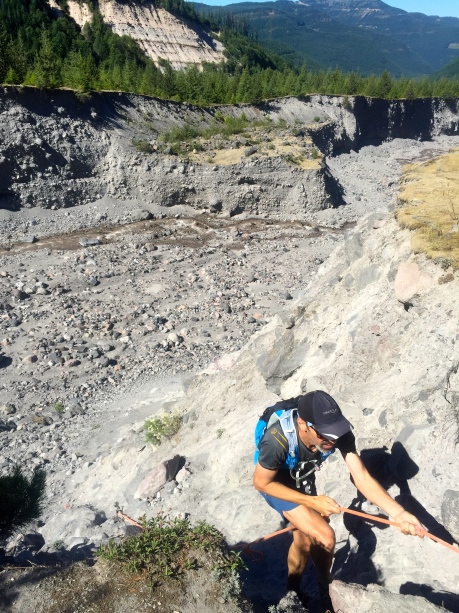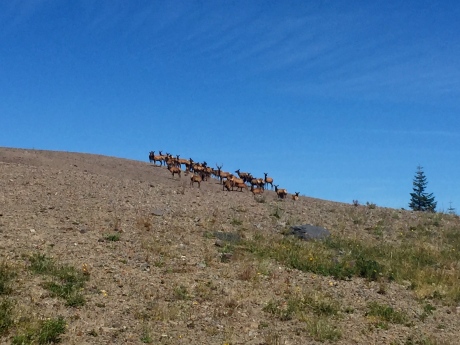After a decades-long relationship with road running, I have finally found the love and support I truly need — and deserve! — on the trails.
This was a breakout season for me: I hung up the road flats. I embraced distance. I took the mountain air. I soaked my eyeballs in Western landscapes. I practiced downhill running. I pranced over boulder fields. I capered through stream beds. I surged up scree fields. I raced for the W, and even got it — once.
As of yesterday, I had run three 50k trail races and won the Northwest Mountain Trail Series.
| Race | Distance | Elevation | Place | Time | Points |
| Mt Hood 50k | 50 km | 2,500′ | 2nd | 3:26 | 98.5 |
| Volcanic 50 | 50+ km | 7,000′ | 2nd | 5:27 | 98.4 |
| Elk-King’s 50k | 50 km | 6,000′ | 1st | 4:24 | 100 |
Now were I a sponsored professional runner (cough hint cough, shoe and apparel companies), I might find the time to give each of these races the special attention they deserve. As it stands, I am a professional mathematician who should be unpacking boxes from a move that happened three weeks ago. So, citing a peculiar combination of laziness and busyness, I have opted to relay some vignettes and pictures from this season’s training and racing and call it a day.
Before I get to that, though, huge kudos to the folks who made this possible. Go Beyond Racing put on all of these events and could not run them better if they tried (and yet still, they try); thank you Todd and Renee and the rest of the crew and the army of volunteers. Trail Factor is full of wonderful people who have shared amazing advice and trail running wisdom; Jason Leman and Marta Fisher have been especially generous. As friend and training-partner-when-colocated, David Ayala has been a huge inspiration as he burst onto the Montana ultra scene and took fourth in the Wasatch Front 100. Ben Nelson at Lifestyles Physical Therapy has been a tremendous help in managing an achilles flare up. And of course and most of all, Sarah has been hugely supportive of this odd running habit even when life is so busy we can’t see straight. Thank you.
Chamonix
After stutter starting through the first four months of the year, my training really got going in May. That gave me just enough buildup to feel fit when I spent 10 days in late June in Chamonix, the Disneyworld of French Alpine playgrounds. [Mandatory pause to revel in my parents’ excellent choice of family vacation spots. Thanks, Mom and Dad!]
Running the Chamonix trails hit the reset button on my perception of hill steepness and length. I got to spend the rest of the season thinking “This is hardly anything compared to the two vertical kilometers of gain I could get from the Chamonix valley!” Highlights of the trip included getting passed by a free soloing Kilian Jornet during a guided mixed climb of the Arête des Cosmiques.
St Helens — the preview
My goal race for the season was the the Volcanic 50, so on August 1 (a day that would see temperatures soar to 97ºF), I set out to circumambulate Mt St Helens and learn the course. Go Beyond Racing was hosting a group run, and I ran much of the loop with Don Gallogly.
It was brutally hot, and I took a wrong turn approaching Windy Pass, sending me two miles out of my way. I ran out of water traversing the endless reentrants (frustratingly dry) past the Plains of Abraham. But I nonetheless made a nice 8.5-hour day out of it and got to take in some spectacular views.
Mt Hood 50k
On July 12, I ran the Mt Hood 50k with one word on my mind: systems. If I was going to do well at trail ultras with four to eight miles of rugged terrain between aid stations, I needed to dial in my nutrition and hydration systems under those conditions. So I undertook the Hood 50k — an honest but fast course on the Pacific Crest Trail — with the goal of honing those skills.
Running fast and challenging for the win (only to be succinctly and convincingly outclassed by a very quick Patrick Reaves), were bonuses. I was surprised and pleased by my speed on the course, averaging 6:39 miles despite a conservative start.
Teton Crest Trail
Despite being poorly positioned in both of our race schedules, David and I decided to sneak in some adventure running on August 20. I wrote about our experience on the 41-mile long Teton Crest Trail here.
Volcanic 50
The Volcanic 50 was my goal race this season. After climbing from the Marble Mountain Sno-Park, the course joins the Loowit Trail for a full clockwise circumnavigation of everyone’s favorite pyroclastic flow site, Mt St Helens.

Running the final descent in the Volcanic 50, about to take second place. Photo: Paul Nelson Photography.
This race has everything: There are climbs on packed dirt. There are boulder fields of volcanic tuff. There are short sections of bushwhacking. There is a river crossing. There’s long sandy climb that will sap your strength. There is a hard-charging Rod Bien who will be ever-so-friendly as he takes the lead from you around mile 18, encouraging you to work with him since this is just a training run for him and he sure would like the company. (You will have the opportunity to replay this scene in your mind many times over.) There is an oasis spring after the blast zone, followed by a steep climb to Windy Pass and scree slope descent to the Plains of Abraham from which you can see Rod Bien’s green shirt not getting closer despite the quick miles you are laying down on this mercifully flat terrain. And then are the reentrants, gravelly gullies with washed out trails that you can stumble through while your right adductor cramps with astonishing ferocity. And finally, there is one more boulder field, followed by one more wooded section, followed by a two-mile screaming descent into the parking lot where you are so so tired and just got second place by five minutes and are 22 minutes under the old course record and you are really happy to have done this and gosh should put on some warm clothes isn’t everyone freezing in this mist?
Elk-King’s 50k
I was tired after the Volcanic 50, but also intrigued to learn that I was high in the standings of the NW Mountain Trail Series despite only having done two races. There were three more scoring races left in the season, the Mountain Lakes 100 and Elk-King’s 25 and 50k races. After an intense season, I had no intention of jumping into a 100-miler tired and unprepared, so had to choose between the two Elk-King’s races. I ran the 25k last year, and knew that it was a brutal, quad-punishing romp over Elk and King’s Mountains on technical terrain. So I decided to wimp out and run the 50k, which has twice as many kilometers (math!) but smoother trails and less climbing per distance (but still 6,000′ of gain).
Yesterday’s run was not my prettiest. My mileage had been relatively low since Volcanic because of general fatigue, an achilles tendinosis flare up, and a doozy of a head cold. I was running tired, but I still ran strong, and it was enough for the win.
I took the lead in the first mile, believing that the flat-ish terrain in the first eight miles favored my road running background. By the first aid station (mile 4), I had a one-minute lead. By the second (10.6 miles), I was up by five minutes. By mile 20 I had 13 minutes on second place, and I would build that to 17 minutes by the finish line.
The first 20 miles are punctuated by 1,300′ and 400′ climbs, which are then repeated in reverse on the way back to the Tillamook Forest Center. My energy and pace felt pretty solid until the 20 mile turnaround, at which point muscular fatigue started to set in. Slopes I had handled at 10-minute pace on the way out became 13-minute pace on the return. My adductor threatened to cramp, but was quelled by a GU and some long thirsty drinks from my handheld. I was living for the final downhill only to be cruelly met with a fierce side stitch as I crested the final 1,300-footer. I ran the next three miles bent over at the side, mimicking Young Frankenstein’s Igor, except that I would have admonished Gene Wilder’s Frederick “No, run this way.” But the stitch subsided and I was able to enjoy the last couple of miles along the Wilson River, finishing on the bridge to the Forest Center amidst the raucous cheers of eight or nine people.

Crossing the finish line at the Tillamook Forest Center. I had envisioned a more enthusiastic celebration….
Per usual with events put on by Go Beyond, there was an excellent party after the race, including a growing number of familiar faces. It was great to share some time off the trails with this excellent and welcoming community, and ultimately celebrate as I picked up some awesome hardware (created by Portland’s own Matt Helms).
The Trail Series win comes with a sweet jacket and free entry into next year’s suite of races. I hope to see everyone there, running hard.












